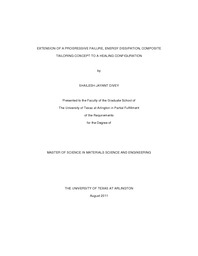
ATTENTION: The works hosted here are being migrated to a new repository that will consolidate resources, improve discoverability, and better show UTA's research impact on the global community. We will update authors as the migration progresses. Please see MavMatrix for more information.
Show simple item record
| dc.contributor.author | Divey, Shailesh Jayant | en_US |
| dc.date.accessioned | 2011-10-11T20:48:37Z | |
| dc.date.available | 2011-10-11T20:48:37Z | |
| dc.date.issued | 2011-10-11 | |
| dc.date.submitted | January 2011 | en_US |
| dc.identifier.other | DISS-11313 | en_US |
| dc.identifier.uri | http://hdl.handle.net/10106/6167 | |
| dc.description.abstract | A composite failure tailoring concept that results in a yield type response under tension has been proposed, modeled, and experimentally verified in prior research. The concept capitalizes upon a sequential, progressive failure of a set of redundant load paths of tailored strength and length. It has been shown in prior publications that the concept is functional and by comparison with experimental results that the analytical models of response developed are accurate. The limits of performance of the proposed tailoring concept have recently been investigated via a parametric study using one of the response models developed and significant improvements have been shown over the performance demonstrated in the earlier work. One of the limitations of the original concept consists in its single-use characteristic, due to the irreversibility of the fracture processes involved. In this study, the failure tailoring concept is extended to a configuration that has the capacity to reconstitute itself after the loading event. This is accomplished by the use of a set of magnets in the primary load path while continuing to use high performance fiber composites for the secondary load path and the connectors. The ability of the primary load path magnets to reattach to each other, thereby reconstituting the primary load path, provides an overall structural healing capability while preserving the energy dissipation characteristic of the original concept implementation. Analytical modeling is provided. This new, extended tailoring concept implementation provides a bridge towards smaller, meso- (fiber level) and nano-scale (molecular) level implementations. However, it must be noted that the model is only of importance for illustrating the concept of healing. The healing features render the new concept of interest for applications such as space tethers | en_US |
| dc.description.sponsorship | Dancila, Dragos Stefan | en_US |
| dc.language.iso | en | en_US |
| dc.publisher | Materials Science & Engineering | en_US |
| dc.title | Extension Of A Progressive Failure, Energy Dissipation, Composite Tailoring Concept To A Healing Configuration | en_US |
| dc.type | M.S. | en_US |
| dc.contributor.committeeChair | Dancila, Dragos Stefan | en_US |
| dc.degree.department | Materials Science & Engineering | en_US |
| dc.degree.discipline | Materials Science & Engineering | en_US |
| dc.degree.grantor | University of Texas at Arlington | en_US |
| dc.degree.level | masters | en_US |
| dc.degree.name | M.S. | en_US |
Files in this item
- Name:
- Divey_uta_2502M_11313.pdf
- Size:
- 1.739Mb
- Format:
- PDF
This item appears in the following Collection(s)
Show simple item record


